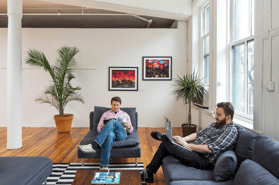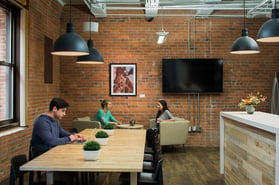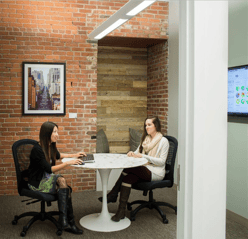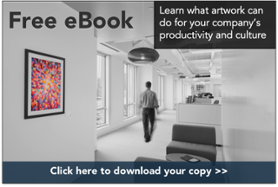Recruiting is a forefront concern for companies of any size, and building a well-tuned recruitment strategy is now more essential than ever. In LinkedIn’s 2015 Global Recruitment Trend report, 53% of US companies cited competition as their greatest recruitment obstacle. In answering the follow-up question “What are the things that your competitors have done or may plan on doing that would make you most nervous?” companies reported “investing in their employer brand” (or in other words, their reputation for being a good place to work) as the greatest threat.
As an art advisor, I’m introduced to many clients in the midst of designing new, bigger spaces in anticipation of, or immediately following, rounds of hiring. In working with companies across a range of industries, I’ve learned that in order to scale up successfully, it’s essential to recognize the measurable power of culture and employer branding in hiring. Studies on millennials–our emerging majority in the workforce–further validate this data, finding Gen Y more likely to select a job for gaining a meaningful experience over a large paycheck.
If your company is hiring, your employer brand can be the X factor in gaining a competitive edge, or possibly the very reason a hire declines your offer. To effectively win over top talent in our increasingly aggressive hiring climate, it’s essential to actively build your employer brand for today’s social, digital recruiting age.
Here are 3 ways to do it:
1. Communicate Values
When it comes to building a successful employer brand, it’s an undebatably top-down procedure. If your company doesn’t embody its brand fundamentally and structurally, a foosball table in the break room won’t bring people through your doors. A brand must be built around the company’s core values, which should be developed early on, and made clear to all employees. This includes new hire orientation where you explicitly lay out those values, but more significantly, it should be clear on a daily basis through the work they’re doing.

Of course, not every task is going to be tied to major business development (which becomes increasingly true as companies scale up). In order to make the occasionally menial feel meaningful, it’s essential for leaders and managers to connect the big picture with the day-to-day to keep the team motivated and engaged in the broader vision. As a result, happy and motivated employees share their positive work experiences, and are more likely to actively spread the word about job openings within their network.
2. Build Culture
Talent wants to feel like their employer cares about them, and rightfully so; in turn, investing in employee well-being shows returns for employers in productivity and retention rates. In a recent study by Jobvite, 73% of the companies surveyed cited highlighting company culture as the the #1 step to take to compete against other employers.
Unsurprisingly, this practice is the norm for some of today’s top companies; Google is notorious for their zany playground-style offices, and whether you’re on board with office climbing walls or not, their goal “to create the happiest, most productive workplace in the world” is one any company should strive for.

There’s no template for creating the best office culture, but implementing an empathic design is where any company should begin the process. To create the right space for your team, consideration should be given to each stage of your employees’ work process, such as community spaces for brainstorming and collaboration; access to power outlets to help people work wherever an idea strikes; private, comfortable, and walled-off spaces for when they need to focus; calming outdoor or naturally-lit areas when they need to recharge, and recreational areas for when it’s time to unwind. Decor details like paint, rugs, plants and artwork can make a sterile commercial building feel comfortable and welcoming, which makes employees happy to be there.
By taking into consideration the quality of an employee’s experience in the office, they will feel valued, which is fundamental in creating a positive culture and reputation as a great place to work. Additionally, a well-designed office is your opportunity to make a strong first impression when interviewing recruits by offering a direct and visual communication of your company culture.
3. Be Social
Employer branding in the digital age is all about public content, so utilize social media to tell your company’s story. According to CareerBuilder’s 2015 Candidate Behavior study, before sending an application, candidates tap into their social networks to get a more transparent look at the company they are considering, which consists of visiting the company’s career site, networking with colleagues, family and friends, and checking out its social media presence. Of those three sources, research by Employer Brand International found social media to be the best channel for companies to communicate their employer brand.

Social media sites distinguish themselves from other branding channels by enabling companies to consistently communicate their culture and values through showing rather than telling. For savvy, millennial candidates interested in establishing a meaningful connection to their company’s mission, social media provides a more authentic and effective picture of that mission than a prepared statement in the “about” section of a company website does. To achieve this, capture the cultural moments you’re already creating and share them across your channels to show potential hires who you are, and why you’re a great company to work for.
You can learn more about candidate behavior here, and if you’d like to learn about how artwork can improve your company’s culture, check out our ebook below:

.jpg?width=332&height=177&name=_MG_0840%20copy%20(2).jpg)

.jpg?width=332&height=177&name=dtBv_067_DSC_2139_DaNil%20(2).jpg)



